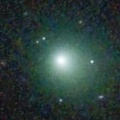
|
It brightened rapidly. Now it is very bright as 10.3 mag (June 15, Goiato). It stays observable at 10-11 mag in good condition for a long time from spring to summer.
Date(TT) R.A. (2000) Decl. Delta r Elong. m1 Best Time(A, h)
June 19 13 42.12 15 30.2 1.518 2.072 108 11.0 21:03 ( 44, 64)
June 26 13 46.72 12 19.7 1.558 2.063 104 11.0 21:04 ( 49, 58)
|
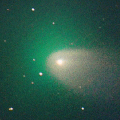
|
Now it is very bright as 9.7 mag (June 4, Michael Jager). It stays bright as 10-12 mag until August. In the Southern Hemisphere, it stays observable in excellent condition for a long time. In the Northern Hemisphere, it becomes extremely low after July.
Date(TT) R.A. (2000) Decl. Delta r Elong. m1 Best Time(A, h)
June 19 22 40.49 -23 56.8 0.445 1.266 114 11.3 2:58 (331, 26)
June 26 23 3.63 -28 41.5 0.456 1.288 116 11.2 3:01 (335, 22)
|
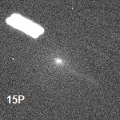
|
Now it is very bright as 11.4 mag (June 6, Thomas Lehmann). It will brighten very rapidly, and it will brighten up to 10 mag from July to August. It stays observable in the morning sky for a long time.
Date(TT) R.A. (2000) Decl. Delta r Elong. m1 Best Time(A, h)
June 19 1 49.51 6 28.8 1.088 1.054 60 11.8 2:58 (273, 16)
June 26 2 21.73 10 17.9 1.097 1.024 57 11.3 3:01 (269, 17)
|
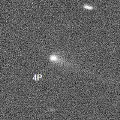
|
Now it is 13.3 mag (June 8, Ken-ichi Kadota). It will brighten up to 10 mag from summer to autumn, and it will be observable in excellent condition. Appearing in the morning sky.
Date(TT) R.A. (2000) Decl. Delta r Elong. m1 Best Time(A, h)
June 19 1 26.82 11 34.9 2.033 1.819 63 12.5 2:58 (272, 23)
June 26 1 44.64 12 53.7 1.954 1.789 65 12.3 3:01 (272, 26)
|
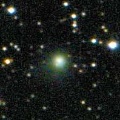
|
Now it is 12.2 mag (May 31, Thomas Lehmann). It will brighten up to 10 mag in winter in 2022. In the Northern Hemisphere, it stays observable in good condition for a long time, although it becomes extremely low temporarily from May to June. In the Southern Hemisphere, it is not observable until November.
Date(TT) R.A. (2000) Decl. Delta r Elong. m1 Best Time(A, h)
June 19 4 51.85 49 44.6 4.868 4.007 28 12.4 2:58 (214, 9)
June 26 5 5.21 49 29.6 4.828 3.978 29 12.3 3:01 (216, 11)
|
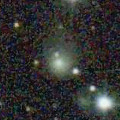
|
Now it is 12.3 mag (June 10, Toshihiko Ikemura, Hirohisa Sato). It is expected to be observable at 5-6 mag for a long time from 2022 to 2023. In the Northern Hemisphere, it is not observable at the high light from 2022 summer to 2023 summer. In the Southern Hemisphere, it stays extremely low for a while. But it will be observable in good condition at the high light.
Date(TT) R.A. (2000) Decl. Delta r Elong. m1 Best Time(A, h)
June 19 17 44.42 43 18.0 5.610 6.083 113 12.6 23:52 (180, 82)
June 26 17 37.83 42 55.5 5.554 6.025 113 12.5 23:18 (180, 82)
|
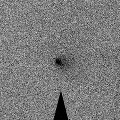
|
Now it is 11 mag (May 12, Giuseppe Pappa). In the Southern Hemisphere, it is locates high in the morning sky. Appearing in the morning sky also in the Northern Hemisphere.
Date(TT) R.A. (2000) Decl. Delta r Elong. m1 Best Time(A, h)
June 19 2 32.33 5 30.0 2.118 1.672 50 12.8 2:58 (268, 6)
June 26 2 48.32 6 21.1 2.109 1.709 53 13.0 3:01 (269, 10)
|
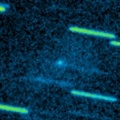
|
Now it is 16.1 mag (June 8, Ken-ichi Kadota). Brightening very rapidly. It will brighten up to 8.5 mag from September to October. But the condition is bad in this apparition. In the Northern Hemisphere, it is observable only in the extremely low sky until July. In the Southern Hemisphere, it will be observable after late August. But it stays locating low for a while.
Date(TT) R.A. (2000) Decl. Delta r Elong. m1 Best Time(A, h)
June 19 4 38.43 42 23.4 2.319 1.452 24 13.4 2:58 (221, 6)
June 26 5 5.71 40 38.7 2.261 1.385 23 13.0 3:01 (223, 5)
|
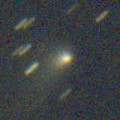
|
Now it is bright as 12.3 mag (June 15, Marco Goiato). It stays 13 mag until early summer. In the Southern Hemisphere, it stays observable in good condition for a long time. It locates somewhat low in the Northern Hemisphere.
Date(TT) R.A. (2000) Decl. Delta r Elong. m1 Best Time(A, h)
June 19 14 12.66 -17 1.5 2.673 3.404 128 13.3 21:03 ( 13, 37)
June 26 14 3.50 -14 51.8 2.799 3.416 119 13.4 21:04 ( 24, 37)
|
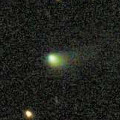
|
Now it is 13.9 mag (May 13, Taras Prystavski). It stays 13-14 mag from 2020 to 2021. It will be observable in good condition after this in the Southern Hemisphere. It locates somewhat low in the Northern Hemisphere.
Date(TT) R.A. (2000) Decl. Delta r Elong. m1 Best Time(A, h)
June 19 19 20.87 -31 21.1 1.964 2.932 158 13.6 1:33 ( 0, 24)
June 26 19 16.05 -32 11.6 1.948 2.940 164 13.6 1:01 ( 0, 23)
|
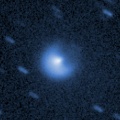
|
Appearing in the morning sky soon.
Date(TT) R.A. (2000) Decl. Delta r Elong. m1 Best Time(A, h)
June 19 4 2.23 28 33.7 6.797 5.889 24 13.9 2:58 (236, 2)
June 26 4 8.11 28 51.0 6.752 5.891 29 13.9 3:01 (239, 7)
|
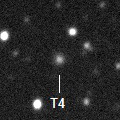
|
Now it is 14.3 mag (June 6, Chris Wyatt). It is expected to brighten up to 11.5 mag in 2022. It is observable in excellent condition in the Southern Hemisphere. In the Northern Hemisphere, it is not observable until November.
Date(TT) R.A. (2000) Decl. Delta r Elong. m1 Best Time(A, h)
June 19 8 48.89 -23 51.1 5.503 5.143 64 14.0 21:03 ( 71,-14)
June 26 8 55.74 -23 23.7 5.539 5.112 60 14.0 21:04 ( 74,-18)
|
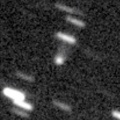
|
Now it is 14.7 mag (June 15, Chris Wyatt). It was expected to brighten up to 13 mag from spring to summer. But actually, it is fainter than originally expected. It stays 14-15 mag until early autumn. In the Southern Hemisphere, it stays observable in good condition for a long time. In the Northern Hemisphere, it is not observable until July in 2022.
Date(TT) R.A. (2000) Decl. Delta r Elong. m1 Best Time(A, h)
June 19 23 0.56 -83 25.8 3.051 3.596 114 14.5 2:58 (356,-29)
June 26 23 25.39 -84 22.1 3.053 3.596 114 14.5 3:01 (356,-30)
|
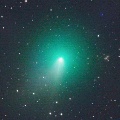
|
It brightened up to 8.9 mag in April (Apr. 12, Carlos Labordena). Now it is fading. It has already faded down to 14.0 mag (June 6, Chris Wyatt). It will be fading and getting lower rapidly after this. It will be unobservable at 17 mag in July.
Date(TT) R.A. (2000) Decl. Delta r Elong. m1 Best Time(A, h)
June 19 10 54.58 18 16.2 2.077 1.985 70 14.6 21:03 ( 89, 35)
June 26 10 54.12 17 11.7 2.296 2.069 64 15.0 21:04 ( 92, 28)
|

|
Now it is 14.6 mag (June 9, Toshihiko Ikemura, Hirohisa Sato). It stays at 14-15 mag for a long time from 2021 to 2022. It stays observable in good condition after this while brightening gradually.
Date(TT) R.A. (2000) Decl. Delta r Elong. m1 Best Time(A, h)
June 19 17 18.34 -3 43.9 4.142 5.103 158 14.7 23:26 ( 0, 51)
June 26 17 10.29 -4 39.2 4.153 5.092 155 14.7 22:51 ( 0, 50)
|
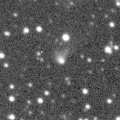
|
Now it is 14.8 mag (June 13, Thomas Lehmann). It stays 14-15 mag until the end of 2021. In the Southern Hemisphere, it stays observable in good condition for a long time. In the Northern Hemisphere, it is not observable until June.
Date(TT) R.A. (2000) Decl. Delta r Elong. m1 Best Time(A, h)
June 19 23 43.63 -34 38.2 4.023 4.385 104 14.7 2:58 (324, 9)
June 26 23 43.71 -34 28.5 3.944 4.395 109 14.7 3:01 (330, 13)
|
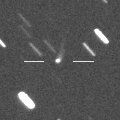
|
It will brighten up to 14.5 mag from spring to summer. In the Southern Hemisphere, it stays observable in excellent condition for a long time. In the Northern Hemisphere, it is not observable after this.
Date(TT) R.A. (2000) Decl. Delta r Elong. m1 Best Time(A, h)
June 19 5 17.56 -68 43.7 2.477 2.715 92 14.7 2:58 (336,-46)
June 26 6 11.50 -68 24.7 2.505 2.732 91 14.8 3:01 (336,-48)
|
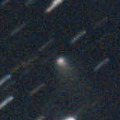
|
Now it is 14.9 mag (June 14, Michael Jager). It will brighten up to 14 mag in summer, and it will be observable in excellent condition. It locates somewhat low in the Southern Hemisphere.
Date(TT) R.A. (2000) Decl. Delta r Elong. m1 Best Time(A, h)
June 19 21 14.30 21 26.1 1.962 2.538 113 15.1 2:58 (334, 75)
June 26 20 54.00 24 28.1 1.849 2.507 119 14.8 2:39 ( 0, 79)
|

|
It brightened up to 11.6 mag in winter (Feb. 18, Thomas Lehmann). Now it is fading. It has already faded down to 14.2 mag (May 11, Thomas Lehmann). In the Southern Hemisphere, it stays observable in good condition after this. In the Northern Hemisphere, it will never be observable after this.
Date(TT) R.A. (2000) Decl. Delta r Elong. m1 Best Time(A, h)
June 19 5 9.11 -52 32.2 3.063 2.993 76 15.0 2:58 (312,-48)
June 26 5 14.55 -52 44.3 3.115 3.058 77 15.2 3:01 (312,-44)
|
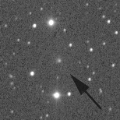
|
Now it is 14.2 mag (June 10, Thomas Lehmann). It stays 15 mag until summer. In the Southern Hemisphere, it stays observable in good condition until June. In the Northern Hemisphere, it is observable in the low sky from March to May.
Date(TT) R.A. (2000) Decl. Delta r Elong. m1 Best Time(A, h)
June 19 8 35.83 5 26.0 2.599 1.994 43 15.1 21:03 ( 97, 0)
June 26 8 49.07 7 29.8 2.660 1.982 39 15.1 21:04 (101, -2)
|
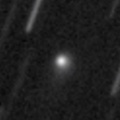
|
Now it is 15.6 mag (June 3, Michael Jager). In the Northern Hemisphere, it stays observable at 15-16 mag for a long time from spring to early 2022. In the Southern Hemisphere, it is not observable until the end of 2021.
Date(TT) R.A. (2000) Decl. Delta r Elong. m1 Best Time(A, h)
June 19 12 50.39 71 1.2 3.211 3.066 72 15.3 21:03 (164, 51)
June 26 12 36.75 67 34.4 3.245 3.053 70 15.3 21:04 (156, 50)
|

|
Now it is 15.3 mag (June 6, Chris Wyatt). It will brighten up to 13 mag in 2022. In 2021, it is observable at 14-15 mag in good condition.
Date(TT) R.A. (2000) Decl. Delta r Elong. m1 Best Time(A, h)
June 19 12 59.58 -1 11.6 3.110 3.535 106 15.3 21:03 ( 43, 45)
June 26 13 1.23 -1 41.5 3.192 3.520 100 15.4 21:04 ( 50, 40)
|
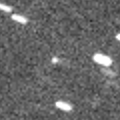
|
Now it is 16.2 mag (June 13, Thomas Lehmann). It will brighten up to 9 mag, and will be observable in good condition in winter.
Date(TT) R.A. (2000) Decl. Delta r Elong. m1 Best Time(A, h)
June 19 0 6.96 -3 40.2 1.744 1.980 87 15.8 2:58 (299, 29)
June 26 0 20.30 -2 19.7 1.624 1.924 90 15.5 3:01 (301, 33)
|
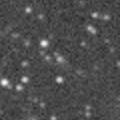
|
Now it is 15.1 mag (June 8, Toshihiko Ikemura, Hirohisa Sato). It stays observable at 15-16 mag in good condition until autumn.
Date(TT) R.A. (2000) Decl. Delta r Elong. m1 Best Time(A, h)
June 19 16 52.92 -21 9.3 3.899 4.893 166 15.5 23:01 ( 0, 34)
June 26 16 47.90 -19 57.2 3.927 4.887 158 15.6 22:29 ( 0, 35)
|

|
It has not been observed yet in this apparition. The condition of this apparition is bad. It must have brightened up to 15.5 mag in spring, however, it is not observable until autumn when it becomes fainter than 19 mag.
Date(TT) R.A. (2000) Decl. Delta r Elong. m1 Best Time(A, h)
June 19 5 37.32 26 9.7 2.263 1.251 3 15.7 2:58 (223,-14)
June 26 6 5.62 26 25.1 2.285 1.274 4 15.9 3:01 (223,-14)
|

|
Now it is 15.7 mag (June 9, Toshihiko Ikemura, Hirohisa Sato). It is expected to brighten up to 13 mag in 2022. In the Southern Hemisphere, it stays observable in good condition for a long time. In the Northern Hemisphere, it stays observable until June, but it will not be observable at the high light.
Date(TT) R.A. (2000) Decl. Delta r Elong. m1 Best Time(A, h)
June 19 12 7.63 -20 24.3 4.299 4.616 101 15.8 21:03 ( 42, 22)
June 26 12 4.64 -20 28.8 4.371 4.571 94 15.8 21:04 ( 48, 17)
|
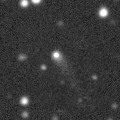
|
Now it is 15.7 mag (May 27, ATLAS-HKO, Haleakala). It stays observable at 16 mag from 2021 to 2022.
Date(TT) R.A. (2000) Decl. Delta r Elong. m1 Best Time(A, h)
June 19 13 38.04 -2 44.9 4.243 4.775 115 15.8 21:03 ( 29, 48)
June 26 13 37.48 -1 47.7 4.341 4.765 108 15.9 21:04 ( 39, 46)
|

|
Now it is 15.7 mag (June 9, Toshihiko Ikemura, Hirohisa Sato). In the Northern Hemisphere, it stays observable for a long time while it is getting fainter slowly. In the Southern Hemisphere, it will never be observable again.
Date(TT) R.A. (2000) Decl. Delta r Elong. m1 Best Time(A, h)
June 19 13 36.39 62 2.4 6.193 6.116 80 15.9 21:03 (161, 60)
June 26 13 33.12 60 40.5 6.289 6.164 78 15.9 21:04 (154, 59)
|
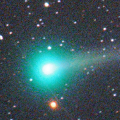
|
It brightened up to 3 mag in December in the SOHO spacecraft images (Dec. 18, Hirohisa Sato). Now it is 15.6 mag (June 15, Michael Jager). It stays observable in good condition after this while the comet will be fading.
Date(TT) R.A. (2000) Decl. Delta r Elong. m1 Best Time(A, h)
June 19 0 20.18 18 24.3 3.347 3.256 76 16.0 2:58 (275, 40)
June 26 0 21.31 18 56.0 3.328 3.343 82 16.1 3:01 (279, 46)
|
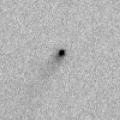
|
Now it is 16.4 mag (May 23, Slooh.com Chile Observatory, La Dehesa). It will brighten up to 15 mag from summer to autumn. In the Southern Hemisphere, it stays observable for a long time. In the Northern Hemisphere, it will be getting higher gradually after this, and it will be observable in good condition after summer.
Date(TT) R.A. (2000) Decl. Delta r Elong. m1 Best Time(A, h)
June 19 2 28.99 3 20.4 2.069 1.659 52 16.2 2:58 (270, 6)
June 26 2 47.21 5 32.1 2.009 1.632 53 16.0 3:01 (270, 9)
|
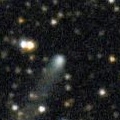
|
Now it is 16.7 mag (June 14, Michael Jager). It stays 15-16 mag until July. In the Northern Hemisphere, it stays observable in good condition for a long time. It is not observable after this in the Southern Hemisphere.
Date(TT) R.A. (2000) Decl. Delta r Elong. m1 Best Time(A, h)
June 19 17 54.56 57 19.0 5.094 5.352 99 16.1 0:07 (180, 68)
June 26 17 40.98 57 43.4 5.137 5.382 98 16.1 23:20 (180, 67)
|
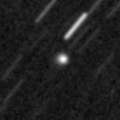
|
Now it is 16.6 mag (June 7, Katsumi Yoshimoto). It is expected to brighten up to 11 mag in 2023. In the Northern Hemisphere, it stays observable in good condition for a long time. It locates extremely low in the Southern Hemisphere.
Date(TT) R.A. (2000) Decl. Delta r Elong. m1 Best Time(A, h)
June 19 17 19.14 50 56.0 6.225 6.567 105 16.2 23:26 (180, 74)
June 26 17 9.45 50 43.8 6.196 6.522 104 16.2 22:49 (180, 74)
|

|
It had been observed as 8-9 mag for a long time in 2020. Now it is fading. It has already faded down to 17.0 mag (May 25, ATLAS-MLO, Mauna Loa). It will be observable in good condition after this in the Southern Hemisphere. It locates extremely low after this in the Northern Hemisphere.
Date(TT) R.A. (2000) Decl. Delta r Elong. m1 Best Time(A, h)
June 19 16 38.37 -46 35.2 4.029 4.955 152 16.2 22:47 ( 0, 8)
June 26 16 31.24 -46 37.9 4.124 5.017 148 16.3 22:12 ( 0, 8)
|
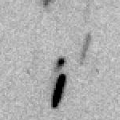
|
Now it is 17.9 mag (June 8, Toshihiko Ikemura, Hirohisa Sato). It is expected to brighten up to 15 mag from summer to autumn, and it will be observable in good condition. However, it is fainter than this ephemeris recently.
Date(TT) R.A. (2000) Decl. Delta r Elong. m1 Best Time(A, h)
June 19 22 57.06 -5 12.4 1.908 2.371 104 16.4 2:58 (316, 40)
June 26 23 3.76 -5 4.6 1.820 2.359 109 16.3 3:01 (322, 43)
|
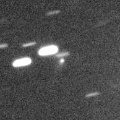
|
Now it is 16.9 mag (June 10, Toshihiko Ikemura, Hirohisa Sato). It will approach to Earth down to 0.2 a.u. in December, and it is expected to brighten up to 4 mag. In the Northern Hemisphere, it stays observable in good condition for a long time until December while the comet is brightening gradually. In the Southern Hemisphere, it is not observable until mid December. Actually, it is somewhat fainter than this ephemeris recently.
Date(TT) R.A. (2000) Decl. Delta r Elong. m1 Best Time(A, h)
June 19 10 30.12 53 50.4 3.631 3.238 59 16.4 21:03 (134, 41)
June 26 10 28.46 52 31.5 3.624 3.153 55 16.3 21:04 (133, 37)
|
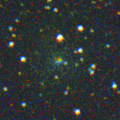
|
Now it is 15.1 mag (May 24, Mike Olason). Appearing in the morning sky. In the Northern Hemisphere, it stays observable in good condition while the comet will be fading. In the Southern Hemipsphere, it stays locating extremely low after this.
Date(TT) R.A. (2000) Decl. Delta r Elong. m1 Best Time(A, h)
June 19 2 55.64 30 46.2 2.967 2.272 39 16.3 2:58 (243, 15)
June 26 3 10.18 32 10.4 2.940 2.293 42 16.5 3:01 (243, 19)
|
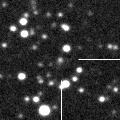
|
Now it is 16.6 mag (June 10, Toshihiko Ikemura, Hirohisa Sato). It stays at 16-17 mag from 2020 to 2021. In the Northern Hemisphere, it stays observable in good condition for a long time. It locates extremely low in the Southern Hemisphere.
Date(TT) R.A. (2000) Decl. Delta r Elong. m1 Best Time(A, h)
June 19 19 21.55 49 54.6 8.540 8.840 103 16.3 1:33 (180, 75)
June 26 19 16.27 50 28.5 8.523 8.842 105 16.3 1:01 (180, 75)
|
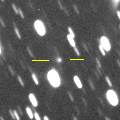
|
Now it is 16.7 mag (June 10, Toshihiko Ikemura, Hirohisa Sato). It is observable at 16 mag from 2020 to 2021. In the Southern Hemisphere, it is not observable until summer.
Date(TT) R.A. (2000) Decl. Delta r Elong. m1 Best Time(A, h)
June 19 23 15.12 44 59.1 6.097 5.995 79 16.4 2:58 (239, 60)
June 26 23 12.17 45 9.6 6.013 6.002 84 16.4 3:01 (236, 66)
|
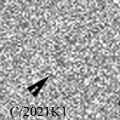
|
Now it is 16.2 mag (May 30, ATLAS-MLO, Mauna Loa). It stays 16.5 mag until August and stays observable in good condition.
Date(TT) R.A. (2000) Decl. Delta r Elong. m1 Best Time(A, h)
June 19 0 20.50 -3 52.1 2.423 2.537 84 16.4 2:58 (296, 27)
June 26 0 29.94 -3 45.4 2.357 2.549 88 16.4 3:01 (300, 31)
|
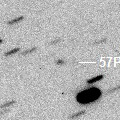
|
Now it is 17.5 mag (June 8, Toshihiko Ikemura, Hirohisa Sato). It will brighten up to 15.5 mag from summer to autumn. It stays observable for a long time.
Date(TT) R.A. (2000) Decl. Delta r Elong. m1 Best Time(A, h)
June 19 15 7.12 -13 4.8 1.146 2.033 140 16.6 21:16 ( 0, 42)
June 26 15 5.67 -12 59.6 1.164 2.002 133 16.5 21:04 ( 6, 42)
|
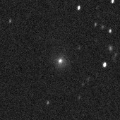
|
Now it is 16.0 mag (June 9, Toshihiko Ikemura, Hirohisa Sato). It is observable at 16.5 mag from spring in 2020 to summer in 2021.
Date(TT) R.A. (2000) Decl. Delta r Elong. m1 Best Time(A, h)
June 19 16 1.79 -18 45.2 4.033 4.969 154 16.6 22:10 ( 0, 36)
June 26 15 52.57 -19 9.2 4.116 4.989 145 16.6 21:33 ( 0, 36)
|
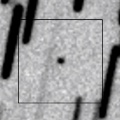
|
Now it is 16.4 mag (June 9, Toshihiko Ikemura, Hirohisa Sato). It will brighten very rapidly, and it will be observable at 10 mag in good condition from October to December. In the Northern Hemisphere, it locates somewhat low at the high light.
Date(TT) R.A. (2000) Decl. Delta r Elong. m1 Best Time(A, h)
June 19 16 21.10 17 12.2 0.821 1.692 133 16.7 22:29 ( 0, 72)
June 26 16 15.91 16 4.6 0.797 1.649 130 16.6 21:57 ( 0, 71)
|
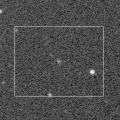
|
Now it is 17.1 mag (June 13, Thomas Lehmann). It will brighten up to 12.5 mag in 2022 summer. In the Southern Hemisphere, it stays observable in excellent condition for a long time. In the Northern Hemisphere, it is not observable until August in 2022.
Date(TT) R.A. (2000) Decl. Delta r Elong. m1 Best Time(A, h)
June 19 3 36.44 -44 49.2 5.361 5.186 74 16.8 2:58 (305,-32)
June 26 3 40.84 -45 47.3 5.253 5.137 77 16.7 3:01 (308,-28)
|
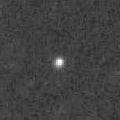
|
Now it is 16.3 mag (June 8, Toshihiko Ikemura, Hirohisa Sato). It is expected to brighten up to 10 mag in 2023. In the Northern Hemisphere, it stays observable in good condition until 2023 autumn. In the Southern Hemipshere, it stays extremely low until mid July, then it becomes unobservable for a while. But it becomes observable in good condition after 2023 summer.
Date(TT) R.A. (2000) Decl. Delta r Elong. m1 Best Time(A, h)
June 19 12 2.18 38 9.4 7.165 7.025 78 16.7 21:03 (108, 56)
June 26 12 1.16 37 50.2 7.209 6.972 72 16.7 21:04 (109, 50)
|
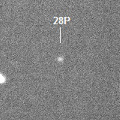
|
Now it is 16.3 mag (May 23, Mike Olason). Appearing in the morning sky. In the Northern Hemisphere, it stays observable in good condition after this while the comet will be fading. In the Southern Hemisphere, it stays locating extremely low for a long time.
Date(TT) R.A. (2000) Decl. Delta r Elong. m1 Best Time(A, h)
June 19 2 55.71 24 22.8 2.632 1.960 39 16.7 2:58 (249, 12)
June 26 3 10.68 25 57.4 2.634 2.007 42 16.8 3:01 (249, 16)
|
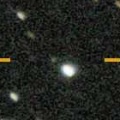
|
Now it is 16.9 mag (June 10, Toshihiko Ikemura, Hirohisa Sato). It is expected to brighten up to 11 mag in 2023. In the Northern Hemisphere, it is observable in good condition in 2021. But it is observable only until November in 2022. In the Southern Hemisphere, it locates extremely low in 2021. But it will be observable in good condition at the high light.
Date(TT) R.A. (2000) Decl. Delta r Elong. m1 Best Time(A, h)
June 19 18 13.02 46 20.7 6.413 6.828 110 17.0 0:25 (180, 79)
June 26 18 7.00 46 2.1 6.356 6.780 110 17.0 23:47 (180, 79)
|
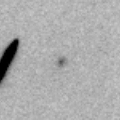
|
Now it is 18 mag (June 10, Jean-Louis Virlichie). It will brighten rapidly up to 15 mag in autumn. It will be observable in excellent condition in the Northern Hemisphere. It locates somewhat low in the Southern Hemisphere.
Date(TT) R.A. (2000) Decl. Delta r Elong. m1 Best Time(A, h)
June 19 1 59.19 4 11.7 2.159 1.848 58 17.3 2:58 (273, 12)
June 26 2 15.65 5 55.4 2.083 1.820 60 17.1 3:01 (274, 16)
|

|
Now it is 16.8 mag (June 10, Toshihiko Ikemura, Hirohisa Sato). It will be fading slowly.
Date(TT) R.A. (2000) Decl. Delta r Elong. m1 Best Time(A, h)
June 19 17 35.21 -13 1.3 6.728 7.728 169 17.1 23:43 ( 0, 42)
June 26 17 29.64 -12 42.2 6.771 7.753 164 17.2 23:10 ( 0, 42)
|
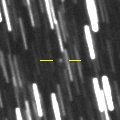
|
Now it is 17.6 mag (June 7, Toshihiko Ikemura, Hirohisa Sato). It will brighten up to 15.5 mag in winter. In the Northern Hemisphere, it stays observable in good condition for a long time. It is not observable at all in the Southern Hemisphere.
Date(TT) R.A. (2000) Decl. Delta r Elong. m1 Best Time(A, h)
June 19 20 49.37 64 43.5 3.654 3.711 85 17.2 2:58 (181, 60)
June 26 20 36.21 67 10.6 3.601 3.671 85 17.1 2:20 (180, 58)
|
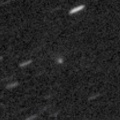
|
Now it is 17.8 mag (June 8, Thomas Lehmann). It will be observable at 11 mag from winter to spring in 2022. In 2021, it is observable until July or August when it brightens up to 16-17 mag.
Date(TT) R.A. (2000) Decl. Delta r Elong. m1 Best Time(A, h)
June 19 10 42.38 12 11.5 3.040 2.854 69 17.3 21:03 ( 84, 29)
June 26 10 48.92 11 28.7 3.088 2.813 64 17.2 21:04 ( 87, 24)
|

|
First return of a new periodic comet observed at 17 mag in 2014. It has not been observed yet in this apparition. It is expected to brighten up to 17 mag from summer to autumn, and it will be observable in good condition.
Date(TT) R.A. (2000) Decl. Delta r Elong. m1 Best Time(A, h)
June 19 0 35.36 9 34.9 1.603 1.675 75 17.3 2:58 (282, 32)
June 26 0 50.48 11 52.5 1.557 1.676 78 17.2 3:01 (282, 37)
|
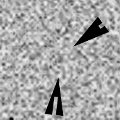
|
Now it is 18.8 mag (June 9, Toshihiko Ikemura, Hirohisa Sato). It will brighten up to 15-16 mag in autumn and it will be observable in good condition.
Date(TT) R.A. (2000) Decl. Delta r Elong. m1 Best Time(A, h)
June 19 23 14.42 -8 52.1 1.784 2.223 101 17.4 2:58 (314, 34)
June 26 23 21.04 -7 43.6 1.700 2.212 106 17.2 3:01 (319, 38)
|
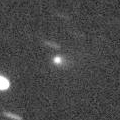
|
First return of a new periodic comet which brightened up to 16 mag in 2014. Now it is 16.9 mag (June 5, Thomas Lehmann). It stays observable at 16-17 mag in good condition until July.
Date(TT) R.A. (2000) Decl. Delta r Elong. m1 Best Time(A, h)
June 19 12 24.07 -0 32.5 1.761 2.153 98 17.2 21:03 ( 53, 40)
June 26 12 30.64 -2 14.6 1.830 2.148 93 17.3 21:04 ( 56, 35)
|
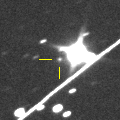
|
Now it is 17.2 mag (May 14, Michael Jager). It stays observable at 17-18 mag for a long time until 2024.
Date(TT) R.A. (2000) Decl. Delta r Elong. m1 Best Time(A, h)
June 19 14 34.86 -6 30.7 8.415 9.105 130 17.3 21:03 ( 7, 48)
June 26 14 31.60 -6 14.6 8.503 9.095 122 17.3 21:04 ( 19, 47)
|
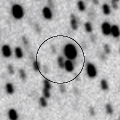
|
Now it is 17.4 mag (June 8, Toshihiko Ikemura, Hirohisa Sato). It is expected to brighten up to 11 mag from spring to summer in 2022. In the Southen Hemisphere, it locates somewhat low in 2021, but it will be observable in good condition at the high light for a long time. In the Northern Hemisphere, it is observable in good condition in 2021, but it will not be observable at the high light.
Date(TT) R.A. (2000) Decl. Delta r Elong. m1 Best Time(A, h)
June 19 20 38.43 38 7.2 4.043 4.446 106 17.5 2:50 (180, 87)
June 26 20 30.83 38 14.6 3.914 4.383 111 17.4 2:15 (180, 87)
|
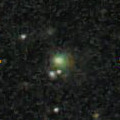
|
It brightened rapidly up to 15.5 mag in April (Apr. 5, Sandor Szabo). Now it is fading. It has already fade down to 17.3 mag (May 30, ATLAS-MLO, Mauna Loa). It will be fainter than 18 mag in July.
Date(TT) R.A. (2000) Decl. Delta r Elong. m1 Best Time(A, h)
June 19 11 42.59 -4 47.9 2.263 2.485 90 17.4 21:03 ( 59, 30)
June 26 11 37.64 -6 28.2 2.418 2.510 83 17.6 21:04 ( 64, 23)
|
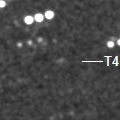
|
In the Northern Hemisphere, it is observable at 17-18 mag from spring to autumn. It is not observable in the Southern Hemisphere.
Date(TT) R.A. (2000) Decl. Delta r Elong. m1 Best Time(A, h)
June 19 4 31.68 73 42.2 2.686 2.200 51 17.6 2:58 (196, 27)
June 26 5 25.69 76 30.8 2.640 2.195 53 17.5 3:01 (193, 27)
|

|
It has not been observed yet in this apparition. It will brighten rapidly up to 9 mag in winter. It will be observable in good condition.
Date(TT) R.A. (2000) Decl. Delta r Elong. m1 Best Time(A, h)
June 19 23 36.46 -37 58.2 2.205 2.679 106 17.9 2:58 (328, 7)
June 26 23 44.82 -39 4.1 2.090 2.629 110 17.6 3:01 (332, 9)
|

|
Now it is 17.7 mag (May 12, ATLAS-HKO, Haleakala). It brightened rapidly. It stays 17-18 mag for a long time from 2021 to 2022. In the Southern Hemisphere, it stays observable in good condition for a long time. In the Northern Hemisphere, it is observable only until May.
Date(TT) R.A. (2000) Decl. Delta r Elong. m1 Best Time(A, h)
June 19 8 23.42 -9 29.5 6.042 5.444 49 17.6 21:03 ( 86,-12)
June 26 8 25.94 -9 60.0 6.096 5.434 45 17.6 21:04 ( 90,-17)
|
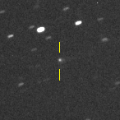
|
Now it is 17.5 mag (June 14, Toshihiko Ikemura, Hirohisa Sato). It will brighten up to 16 mag in 2022. In 2021, it stays observable at 18 mag until September.
Date(TT) R.A. (2000) Decl. Delta r Elong. m1 Best Time(A, h)
June 19 13 20.05 2 6.4 2.804 3.289 109 17.7 21:03 ( 39, 50)
June 26 13 21.76 1 27.2 2.883 3.277 103 17.7 21:04 ( 47, 46)
|
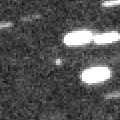
|
First return of a new periodic comet which brightened up to 14 mag in 2010. Now it is 18.7 mag (Apr. 14, Toshihiko Ikemura, Hirohisa Sato). The condition is bad in this apparition. It is observable only until June in the Northern Hemisphere when it brightens up to 18 mag, or until August in the Southern Hemisphere when it brightens up to 17 mag.
Date(TT) R.A. (2000) Decl. Delta r Elong. m1 Best Time(A, h)
June 19 9 32.55 9 51.0 2.533 2.116 54 17.8 21:03 ( 92, 13)
June 26 9 45.09 8 49.7 2.553 2.076 51 17.7 21:04 ( 94, 10)
|
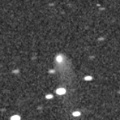
|
It brightened up to 13.8 mag in autumn in 2019 (Sept. 3, 2019, Chris Wyatt). Now it is fading slowly. It stays 18 mag until autumn.
Date(TT) R.A. (2000) Decl. Delta r Elong. m1 Best Time(A, h)
June 19 0 48.78 18 19.1 8.242 7.947 69 17.9 2:58 (271, 34)
June 26 0 49.65 18 50.7 8.178 7.990 75 17.9 3:01 (274, 41)
|
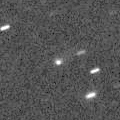
|
Now it is 17.9 mag (June 11, Thomas Lehmann). It stays 17-18 mag for a long time from 2021 to 2023.
Date(TT) R.A. (2000) Decl. Delta r Elong. m1 Best Time(A, h)
June 19 10 50.90 10 0.1 5.043 4.837 72 17.9 21:03 ( 81, 29)
June 26 10 54.90 9 29.9 5.136 4.832 67 17.9 21:04 ( 84, 24)
|
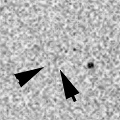
|
Now it is 20 mag (May 28, Giuseppe Pappa). It will brighten up to 14.5 mag in 2022 winter. In 2021, it stays observable in good condition while the comet will be brightening gradually.
Date(TT) R.A. (2000) Decl. Delta r Elong. m1 Best Time(A, h)
June 19 23 2.73 -12 7.9 3.068 3.479 105 18.1 2:58 (319, 33)
June 26 23 5.34 -12 11.3 2.949 3.453 111 17.9 3:01 (326, 36)
|
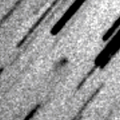
|
Now it is 18.6 mag (May 14, Michael Jager). In the Northern Hemisphere, it stays observable at 18 mag for a long time from 2021 to 2022. It is not observable in the Southern Hemisphere.
Date(TT) R.A. (2000) Decl. Delta r Elong. m1 Best Time(A, h)
June 19 16 50.22 56 26.2 6.853 7.086 99 17.9 22:57 (180, 69)
June 26 16 39.92 56 21.0 6.882 7.088 97 17.9 22:19 (180, 69)
|
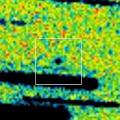
|
It was expected to brighten up to 13 mag from spring to summer. But actually, it is extremely faint as 19.0 mag (Mar. 22, A. C. Gilmore, P. M. Kilmartin). In the Southern Hemisphere, it stays observable in good condition for a long time. In the Northern Hemisphere, it is not observable until late August.
Date(TT) R.A. (2000) Decl. Delta r Elong. m1 Best Time(A, h)
June 19 4 11.33 -37 2.4 1.678 1.547 64 19.1 2:58 (294,-35)
June 26 4 34.90 -34 49.6 1.729 1.562 63 19.2 3:01 (292,-33)
|
|
![]()
 C/2020 Y2 ( ATLAS )
C/2020 Y2 ( ATLAS ) C/2020 H6 ( ATLAS )
C/2020 H6 ( ATLAS ) C/2018 N2 ( ASASSN )
C/2018 N2 ( ASASSN ) C/2020 S3 ( Erasmus )
C/2020 S3 ( Erasmus ) 106P/Schuster
106P/Schuster C/2019 K7 ( Smith )
C/2019 K7 ( Smith ) C/2019 U5 ( PanSTARRS )
C/2019 U5 ( PanSTARRS ) C/2017 T2 ( PanSTARRS )
C/2017 T2 ( PanSTARRS ) 284P/McNaught
284P/McNaught C/2021 A1 ( Leonard )
C/2021 A1 ( Leonard ) 17P/Holmes
17P/Holmes C/2019 O3 ( Palomar )
C/2019 O3 ( Palomar ) C/2019 T3 ( ATLAS )
C/2019 T3 ( ATLAS ) C/2021 K1 ( ATLAS )
C/2021 K1 ( ATLAS ) 57P/du Toit-Neujmin-Delporte
57P/du Toit-Neujmin-Delporte C/2017 Y2 ( PanSTARRS )
C/2017 Y2 ( PanSTARRS ) 6P/d'Arrest
6P/d'Arrest C/2020 R7 ( ATLAS )
C/2020 R7 ( ATLAS ) C/2020 V2 ( ZTF )
C/2020 V2 ( ZTF ) 28P/Neujmin 1
28P/Neujmin 1 C/2020 K1 ( PanSTARRS )
C/2020 K1 ( PanSTARRS ) 108P/Ciffreo
108P/Ciffreo C/2017 U7 ( PanSTARRS )
C/2017 U7 ( PanSTARRS ) C/2021 D2 ( ZTF )
C/2021 D2 ( ZTF ) 22P/Kopff
22P/Kopff P/2014 W12 ( Gibbs )
P/2014 W12 ( Gibbs ) 193P/LINEAR-NEAT
193P/LINEAR-NEAT 413P/2020 W4 ( Larson )
413P/2020 W4 ( Larson ) C/2020 F2 ( ATLAS )
C/2020 F2 ( ATLAS ) C/2021 E3 ( ZTF )
C/2021 E3 ( ZTF ) C/2020 S8 ( Lemmon )
C/2020 S8 ( Lemmon ) C/2020 T4 ( PanSTARRS )
C/2020 T4 ( PanSTARRS ) 19P/Borrelly
19P/Borrelly C/2020 F7 ( Lemmon )
C/2020 F7 ( Lemmon ) 152P/Helin-Lawrence
152P/Helin-Lawrence 418P/2020 Y5 ( LINEAR )
418P/2020 Y5 ( LINEAR ) C/2017 B3 ( LINEAR )
C/2017 B3 ( LINEAR ) 99P/Kowal 1
99P/Kowal 1 119P/Parker-Hartley
119P/Parker-Hartley C/2016 Q2 ( PanSTARRS )
C/2016 Q2 ( PanSTARRS ) C/2020 K5 ( PanSTARRS )
C/2020 K5 ( PanSTARRS )![]()






























































